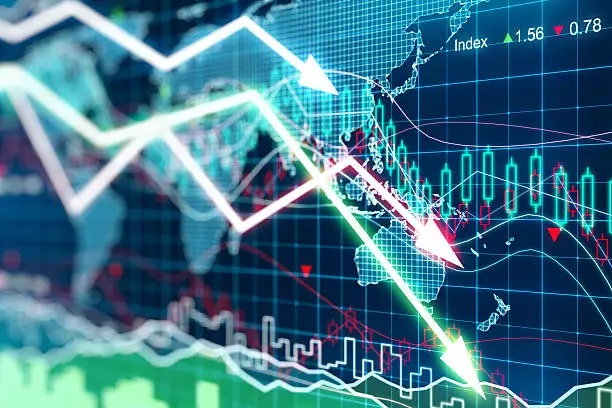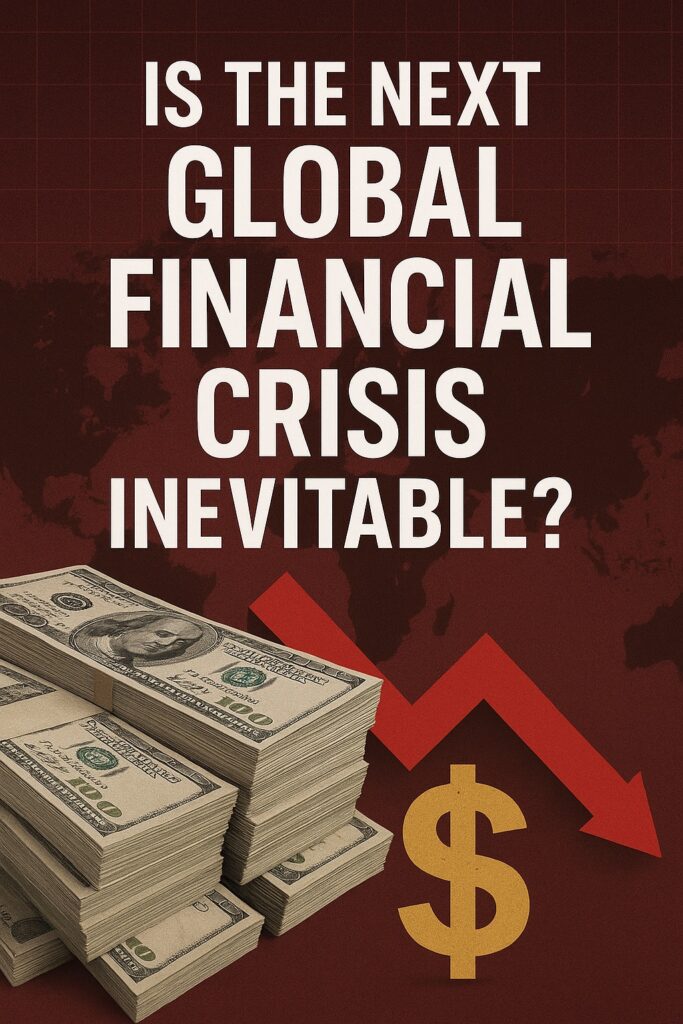
With global debt soaring past $250 trillion and both rich and poor nations buckling under record borrowing, economists fear the world could be heading toward another financial crisis. Rising military spending, debt traps in developing economies, and post-pandemic vulnerabilities are converging into a perfect storm.
India’s experience remains somewhat distinct. During the 200 global financial crisis, India was spared the worst because much of its population and domestic economy were not tightly integrated into global financial markets. Its industrial base was largely self-reliant, and domestic consumption cushioned the blow.
By Newswriters News Desk
A Debt Load of Unprecedented Scale
Global debt—public and private combined—has reached an extraordinary level, raising questions about its sustainability. According to the International Monetary Fund (IMF), total global debt in 2023 was approximately US $250 trillion, or about 237 percent of global GDP. This is a record high, surpassing pre-pandemic levels and dwarfing the figures seen before the 2008 crisis.
Public debt alone is projected by the IMF to approach or exceed 100 percent of global GDP within the next few years. Advanced economies such as the United States, France, and the United Kingdom are already in the danger zone, with government debt hovering around 120–125 percent of GDP. Japan remains an outlier, with public debt exceeding 200 percent of GDP, though much of it is domestically held.
Such debt levels reduce fiscal space, heighten interest-rate sensitivity, and make countries vulnerable to sudden capital-market reversals. What began as a post-COVID response may now be sowing the seeds of the next financial storm.
Private Creditors and the Shifting Landscape
For decades, the IMF and the World Bank were the principal lenders to developing economies. That equation has changed. The IMF has increasingly allowed private lenders—commercial banks, hedge funds, and bond markets—to participate in sovereign lending, expanding both opportunities and risks.
Private creditors now account for nearly one-fifth of the external debt of low-income countries, a sharp rise from two decades ago. This shift has complicated debt restructuring efforts, as private bondholders demand higher yields and resist collective restructuring. In effect, global debt has become more fragmented, more expensive, and less manageable.
Developing Countries in the Debt Trap
Across the developing world, especially in Africa and South Asia, nations borrowed heavily in the 2010s to fund infrastructure and energy projects. Many of these loans carried double-digit interest rates or were tied to commodity exports. The result is that dozens of countries are now either in or near debt distress.
The IMF estimates that more than half of low-income countries are at high risk of default. Weak currencies, shrinking foreign exchange reserves, and rising U.S. interest rates have made dollar-denominated repayments especially painful. The so-called “debt trap” has become not just an economic concern but a geopolitical one, with nations forced to choose between austerity and default.
The Ten Countries Worst Hit by the Debt Trap
According to IMF and World Bank assessments, at least ten countries are currently mired in severe debt distress or face a high risk of default—Zambia, Ghana, Ethiopia, Kenya, Sri Lanka, Pakistan, Egypt, Argentina, Lebanon, and Mozambique.
- Zambia became the first African nation to default during the pandemic and continues to negotiate under the G20 Common Framework.
- Ghana suspended bond payments in 2022, crushed by debt service consuming nearly half its revenue.
- Sri Lanka defaulted in 2022 after its reserves collapsed; by 2024, it was spending roughly 75 percent of government revenue—equivalent to 27 percent of GDP—on debt servicing.
- Pakistan, dependent on successive IMF bailouts, now allocates about 57 percent of federal revenue—or nearly 30 percent of GDP—just to service its debt, leaving little room for development or welfare spending.
- Egypt and Kenya are teetering on the edge, burdened by surging energy imports and Chinese project loans.
- Argentina, Lebanon, and Mozambique represent chronic cases of fiscal mismanagement and corruption, perpetuating the debt spiral.
These countries epitomize how over-borrowing, opaque contracts, and weak governance can push entire economies into a cycle of default, restructuring, and stagnation—and serve as a warning for others.
Major Economies Are Not Immune
While the developing world faces the sharpest pain, advanced economies are hardly immune. The U.S. debt-to-GDP ratio stands at about 121 percent, while France and the U.K. each exceed 110 percent. Debt servicing now consumes more than 10 percent of annual budgets in these nations.
In the Eurozone, sluggish growth and persistent inflation have forced central banks into a tightrope act—raising rates to contain inflation but risking fiscal stress for already indebted governments. Japan, with a public debt exceeding 200 percent of GDP, continues to rely on ultra-loose monetary policy and domestic bond absorption to stave off crisis—though such tactics may not be sustainable indefinitely.
Rising Military Expenditures Add to Fiscal Strain
A less-discussed but critical factor behind ballooning debt is military spending. According to the Stockholm International Peace Research Institute (SIPRI), global military expenditure reached US $2.7 trillion in 2024, a 9.4 percent increase in real terms over the previous year.
Geopolitical rivalries—from Ukraine and the Middle East to the Indo-Pacific—have spurred a new arms race. The U.S., China, Russia, and European powers are expanding defense budgets, while developing countries in Africa and Asia follow suit. Every dollar spent on armaments is one less for health, education, or debt reduction—further tightening the fiscal noose.
China’s Expanding Role as Creditor and Resource Seeker
China’s Belt and Road Initiative has transformed it into a leading global lender, particularly to Asia and Africa. Between 2000 and 2020, Chinese institutions extended over US $160 billion in loans to African nations, often collateralized by natural resources such as oil, copper, and cobalt.
While Beijing has offered some debt relief, many recipient countries remain ensnared by opaque contracts and high repayment obligations. Analysts warn that as repayment peaks—estimated at US $35 billion in 2025—defaults could cascade, straining not only debtor nations but also China’s own policy banks.
The result is a subtle geopolitical reshaping: financial dependency translating into strategic leverage over natural resources and political decisions.
Impact of COVID-19 and Post-Pandemic Fragility
The pandemic forced countries to borrow on an unprecedented scale to finance emergency health spending and social protection. Global debt jumped by 28 percent of GDP in 2020 alone, according to the IMF. While this borrowing averted mass collapse, it also eroded fiscal resilience.
Now, as central banks raise interest rates to tame inflation, the cost of servicing that pandemic debt is rising sharply. Many low-income economies are being squeezed from both ends—higher interest rates and slower global trade recovery—leaving them dangerously exposed to default risks.
Who Will Pay When the Music Stops?
The burden of this looming crisis will be distributed unevenly:
- Developing nations will face austerity, currency depreciation, and rising poverty as governments divert funds to debt servicing.
- Advanced economies risk recession and political backlash as they tighten budgets to restore fiscal balance.
- Private creditors and global banks will absorb significant losses in defaults, potentially triggering broader contagion.
- Ultimately, ordinary citizens everywhere will pay—through inflation, reduced public services, or job losses.
India’s Relative Insulation—But Not Immunity
India’s experience remains somewhat distinct. During the 2007–08 global financial crisis, India was spared the worst because much of its population and domestic economy were not tightly integrated into global financial markets. Its industrial base was largely self-reliant, and domestic consumption cushioned the blow.
Even today, while India’s debt has risen, it remains mostly domestically financed. Yet, the country is not immune. Global slowdowns, energy price shocks, and declining export demand can still ripple through its economy. Prudent fiscal management, continued diversification, and limited exposure to volatile external debt have helped, but vigilance remains essential.
The Triggers of the Next Financial Crisis
If another global crisis emerges, it may be sparked by a combination of factors:
- Rising global interest rates, making debt servicing unsustainable.
- Slowing growth, which raises debt-to-GDP ratios even further.
- Geopolitical shocks that disrupt trade and fuel inflation.
- Sovereign defaults in emerging markets triggering investor panic.
- Asset-price corrections in overheated markets, from real estate to tech.
The probability of a 2008-style systemic crash is uncertain, but the conditions for a significant regional or sectoral crisis are clearly in place.
Preventing or Mitigating the Crash
Avoiding a financial meltdown will require coordinated global action:
- Enhanced debt transparency and fair restructuring mechanisms.
- Greater regulation of private creditors and bond markets.
- Prudent fiscal consolidation in both advanced and emerging economies.
- Reduction in military and non-productive expenditures.
- Strengthened global safety nets through the IMF and multilateral banks.
Above all, countries must use periods of growth to rebuild buffers, not expand liabilities. Failure to act collectively may see history repeat itself—with far graver consequences.
Conclusion: Fragility Rising, Urgency Mounting
The world’s financial system today is more leveraged, interconnected, and politically fragmented than at any time in recent memory. From Washington to Colombo, from London to Lusaka, the numbers point in one direction—unsustainable debt.
Whether this evolves into the next global financial crisis depends on how policymakers, creditors, and institutions manage the next few years. The warning lights are flashing. The choice, as ever, is between proactive reform and reactive collapse.
Sources: IMF Global Debt Monitor (2025); World Bank Debt Statistics (2024); SIPRI Military Expenditure Database (2025); Reuters, The Guardian, Chatham House, Lowy Institute.
Top Image: Unsplash




